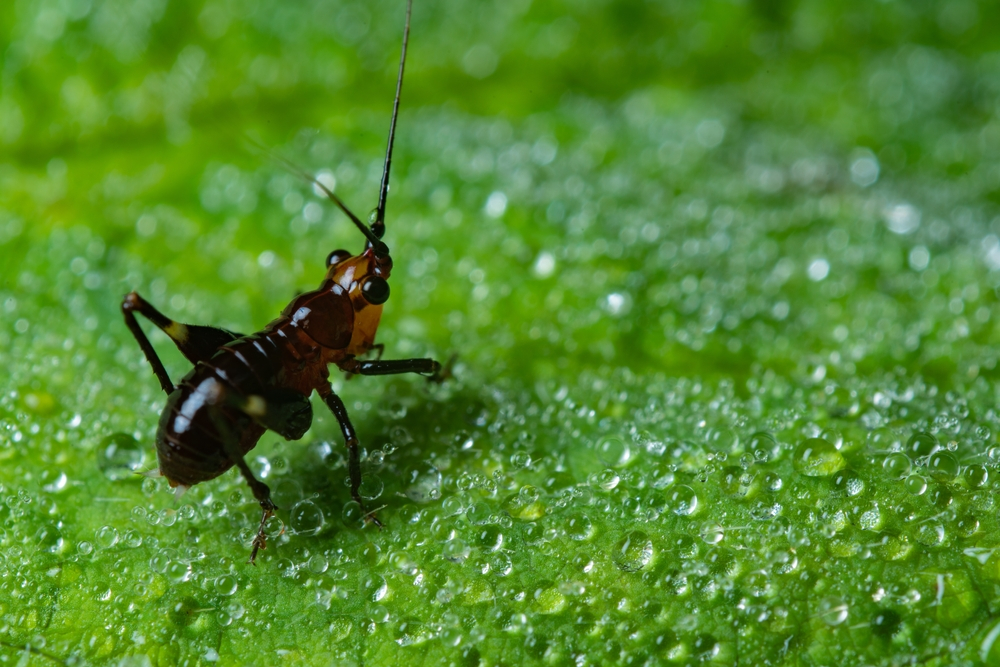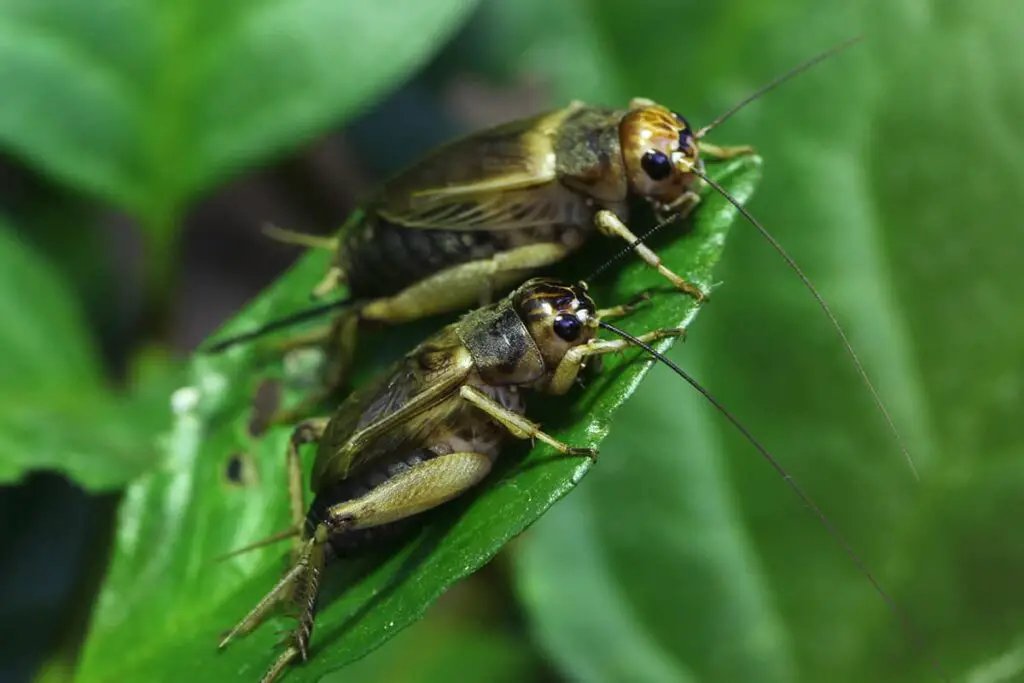Do you ever hear that strange noise in your backyard at night and wonder what it is? More than likely, you hear crickets!
These little insects can be found all over the world, and they come in a variety of shapes and sizes.
But what do crickets eat?
In this blog post, we will take a closer look at the diet of these fascinating creatures!
What Do Crickets Eat?
Crickets are small, nocturnal insects that are known for their chirping sound. Though they are often considered pests, crickets can be beneficial to gardens and lawns.
In fact, crickets play an essential role in the food chain, providing primary food sources for many predators.
But what do crickets eat?
Crickets are omnivorous creatures, meaning they eat just about anything. You can feed crickets on plant matter, such as leaves and roots in the wild.
They will also consume other insects, small mammals, and reptiles. However, their diet is usually much more limited when crickets are kept as pets.
Pet crickets are typically fed dry dog food, cat food, vegetables, and fruit. It is essential to provide a variety of food items to ensure that pet crickets get the nutrients they need to stay healthy.
Though they are not particular about what they eat, crickets do have a few preferences when it comes to food.
First, crickets like their food to be soft and easy to chew. They also prefer foods that are high in carbohydrates and low in protein. This diet helps keep cricket populations healthy and prevents them from becoming cannibalistic.
What Do Baby Crickets Eat?

Baby crickets, also known as nymphs, generally eat the same foods as adult crickets. This includes fruits, vegetables, other insects, and even smaller animals.
In the wild, crickets typically fend for themselves from the time they hatch until adulthood.
However, suppose you’re raising baby crickets in captivity. In that case, you’ll need to provide them with a suitable diet to ensure their health and development.
A wide variety of commercially available cricket foods can provide everything your baby crickets need to thrive.
Fruits and vegetables should make up most of their diet. Still, you can offer them an occasional treat of protein-rich foods such as small insects or pinkie mice.
By feeding the baby crickets nutritious foods, you can help them grow into healthy adults.
What Do Cricket Larvae Eat?
Cricket larvae are voracious eaters and will consume just about any type of organic matter. They have been known to eat other insects, such as aphids, mites, and tiny caterpillars.
In the wild, cave crickets will also eat decaying vegetation, fungi, and even smaller invertebrates. However, in captivity, cricket insect larvae must be provided with a diet that meets their nutritional needs.
This can be accomplished by feeding them commercially available cricket food or providing them with various fresh food.
Several different items can be included in a cricket larva’s diet. Still, it is essential to make sure that the food is chopped into small pieces so they can easily consume it.
Cricket larvae are an essential part of the food chain and play a role in controlling populations of other crickets.
For this reason, it is essential to provide them with a nutritious diet that will allow them to thrive.
What Do Adult Crickets Eat?
Adult crickets are generally omnivorous, meaning they will eat rice cereal, plant, and animal material.
The diet of camel crickets can vary depending on the species. Still, commonly consumed items include other dead insects, plants, fruit, seeds, and even mammalian blood.
In terms of other insects, bush crickets have been known to consume grasshoppers, moths, beetles, and ants.
Given their opportunistic nature, captive crickets will also consume just about any type of plant matter they come across. This can include leaves, stems, flowers, and even bark.
Crickets are also attracted to fruits and vegetables, particularly those overripe or beginning to rot.
And finally, some species of cricket have been known to drink the blood of mammals such as bats or rodents.
While this might seem like a strange dietary choice, it is a fairly common behavior in the animal kingdom.
Read More: Do Crickets Need Ventilation?
How To Get Rid Of Crickets?
Most people are familiar with the sights and sounds of crickets. These tiny insects are often seen leaping around in the grass or heard chirping loudly at night.
While they may be harmless, crickets can become a nuisance if they find their way into your home.
If you’re dealing with a cricket infestation, there are a few things you can do to get rid of them.
First, try to identify where they’re coming from and seal any cracks or openings used to access your home.
Then, set out traps baited with food or pesticide to attract and kill the crickets.
You can also use insecticide sprays to directly target crickets and other pests.
With a little effort, you can rid your home of these unwanted guests.
How To Prevent Crickets From Entering Your Home?
Crickets are one of the most common household pets and can be quite a nuisance. If you’re dealing with a cricket infestation, there are a few things you can do to get rid of them.
First, seal any cracks or openings in your home that crickets could use to get inside. This includes filling gaps around doors and windows and repairing any holes in screens.
You can also use a chemical insecticide to kill any crickets inside your home. Be sure to follow the instructions carefully, and apply the insecticide in all the areas where house crickets could be hiding.
Finally, keep your home clean and free of food debris, as this will attract crickets and other pests.
By taking these steps, you can help to prevent cricket infestations in your home.
Read More: How Long Will a Cricket Live in My House?
Cricket Facts
Cricket bugs, also known as true crickets, are tiny insects that are part of the order Orthoptera.
They are found in a variety of habitats all over the world. They are distinguished from other insects by their long antennae and Jumping ability.
There are more than 9,000 species of cricket bugs, making them one of the largest groups of insects.
Cricket bugs thrive in warm climates and are often found near food sources, such as gardens or manure piles.
They are carnivorous crickets, which will eat plant and animal matter. Cricket bugs typically mate in the summer months, and the female will lay her eggs in the soil, where they will hatch the following spring.
The young crickets, called nymphs, look similar to adults but are smaller and lack fully developed wings. Nymphs will molt several times as they grow and shed their skin each time to reveal a more prominent, mature cricket.
Cricket bugs are most active at night and are attracted to light. They can be nuisance pests if they enter homes for food or shelter.
However, cricket bugs can also be beneficial as they help control populations of harmful insects, such as crop-destroying caterpillars.
Some cricket species are also kept as pets or used in traditional Chinese medicine.
Conclusion
Crickets are small jumping insects that can be found all over the world. There are more than 9,000 species of cricket, and they come in a variety of shapes and sizes. Crickets hunt animal matter, but some species have been known to drink blood.
In this blog, there are few a things you can do to get rid of them.
Do you have a question about crickets we didn’t answer in this blog post? Let us know in the comments below, and we will do our best to provide an answer!
Keep Reading:
What Do Cricket Eggs Look Like?
Where Do Dragonflies Go When It Rains?
Driven by a passion for those tiny creatures that rule our world, we at Bug Domain strive to be your go-to resource for information on insects.




